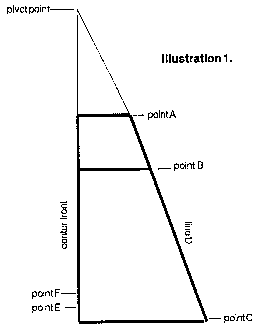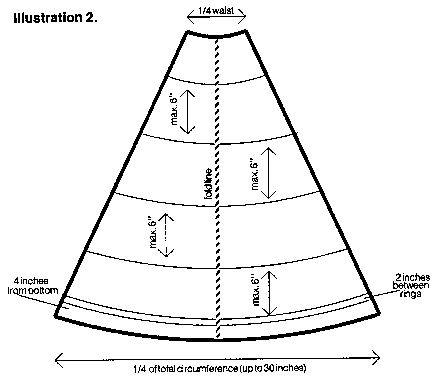
| Short History and Construction |
| of the Spanish Farthingale |
by Baroness Briana Etain MacKorkhill
Previous to the 1470's, gowns were formally pleated to achieve fullness. Then the vertugados (the Spanish name used for the farthingale's predecessor) came along to change the women's silhouette. The name vertugados is derived from the supple hoops of wood which were evenly inserted into the skirt. These circular hoops became called verdugos and were set in a graduated manner to achieve a smooth, bell-shaped skirt.
Some theorized that the vertugados was introduced by members of the nobility to cover up an unwanted pregnancy, but while the skirt could indeed help cover such a condition, the accompanying corset would definitely not aid in the cover-up.
When first introduced the gown over the vertugados was smooth and often split in an inverted V-shape to display the vertugados. At that time the verdugos were plainly visible on the outside of the rich brocade skirt. Gradually, the hoop skirt began to become more of a support under an underskirt rather than the underskirt itself.
When France adopted the hoopskirt in the early 1520's, their name for it was vertugade or vertugale . The French altered the bell-shape by slightly straightening the sides. It became a canvas support with wicker hoops, covered with fabric and then over this was worn the underskirt made of a rich material, thus achieving the form without any of the supports showing.
England named their variation the Spanish farthingale. The English preferred a more cone-like shape to their hoopskirt and by this time it was utilized solely as a support.
By the late 1560's and early 1570's, padded tolls often called bumrolls or bolster rolls were added to the farthingale to provide more support for the, by now, very full skirts. These rolls gradually became so large and cumbersome that even with this addition, it was not sufficient to obtain the desired effect.
When this occurred, another variation was created and was referred to as the wheel, drum or French farthingale. Whereas the Spanish farthingale was cone-shaped, the wheel farthingale utilized the same circumference from top to bottom. The waistband was often gathered, and in the case of the English drum farthingale, had a ruffle that usually covered the top of the drum. It was also constructed with either cane or whalebone evenly spaced from waist to ankle. The fashion for the wheel farthingale lasted into the 1620's.
Construction
The construction of the Spanish farthingale will entail some pattern drafting, and a medium amount of mathematics. I found it advantageous to place the hoops no more than 5-6" from each other and two rings at the bottom for added support. When finished, not only will you have a pattern for a farthingale but you will also have a pattern for the underskirt that fits over the farthingale.
Materials needed:
Tape measure
Yardstick
Measurement sheet
Several large sheets of paper (newspapers, paper sacks, flip chart sheets, etc.)
Bias tape and/or trim for casings (about 15 yards)
Hoop wire (approx. 15 yards) (can be obtained at a costume supply store - KC Costume in Overland Park carries it)
Medium to heavy tightly-woven material (approx. 5 yards) (canvas, duct, linen or heavy broadcloth)
Measurements needed:
Waist __________ +2 = ____________ Hip ___________+3 ___________
Waist to floor measure_________________+2 = ____________________
Bottom circumference of farthingale 117-120"
1. Make sure your paper is at least 12" longer than your adjusted waist to floor measurement. Drop down 12" and draw a line equal to your adjusted waist to floor measurement. This becomes your center front line.
2. At the top of your center front line, draw a line across the paper equal to 1/8 the adjusted waist measurement. This is point A.
3. From the top of the center front line, measure 8 inches down. Now measure across 1/8 the adjusted hip measurement. This is point B.
4. At the bottom of your center front line, measure across 1/8 of the bottom circumference (if using 120 inches it is 15 inches). This is point C.
5. Using the yardstick, connect points A, B, & C. This is line D.
6. Now from the waistline, extend the center frontline up.
7. Now from line D extend this line up until it intersects the center front line.
8. Take the tape measure and place the end at the juncture. This will become the pivot point to provide the necessary curvatures. Holding the end at the juncture, pivot the tape and trace the curve at the waistline. It will arc up to line D.
9. Using the same pivot point, trace the arc at the hip line.
10. Again using the same pivot point, trace the arc at the bottom line.
11. Subtract four inches from the bottom line along the center front. This is point E. Pivot the tape and trace the arc at point E. Then subtract two inches up toward the hip from E and mark this point F and trace another arc. These will become the double hoop lines at the bottom.
12. Measure the distance between the hip line and the point F arc along the center front. Divide that number by 5 (or 6) to ensure that the remaining rings will be spaced evenly. They should be approximately 5 to 6 inches apart.
13. Transfer these numbers to the center front and using the tape measure, trace arcs for each hoop line.

14. You now have a pattern for your farthingale. Place the center front of your pattern on a center fold and cut out four pieces. Be sure to trace your hoop lines before you remove the pattern and be sure to trace them on both sides of the fold.
15. Sew sides together, (French seams work the best) leaving the back seam open from the top to two inches above the hip ring. Finish the edges.
16. Use bias tape to make a casing at the waistline for a drawstring.
17. Sew the trim or casing at each hoop line making sure to leave an opening along the back seam.
18. Turn under the hem and sew. Turn under this and sew again.
19. Measure each ring and cut hoop wire 6 inches longer than that measurement.
20. Insert hoop wire, be careful to overlap it at the back seam. Close the opening by hand.
21. Thread your drawstring in the waist and try on.

Bibliography
Patterns of Fashion 1550-1650 by Janet Arnold.
The Book of Costume by Milia Davenport, Crown Publishers, Printed 1965.
Modes & Manners, Vol. 1 by Max Von Boehn, translated by Joan Joshua,
originally published 1932, reissued 1971 by Benjamin Blom Inc.
European Costume, 4000 Years of Fashion by Doreen Yarwood, Bonanza Books, Printed 1975.
Elizabeth Costuming for the Years 1550-1580. Janet Bigglestone and Carolyn Schultz. An Other Times Production. 2nd edition.
A History of Costume by Karl Kohler. Dover Books. Printed 1978.
©1998, 1999, 2000, 2001, 2002, 2003, 2004, 2005, 2006, 2007 Briana Etain MacKorkhill (Sheryl Knight)